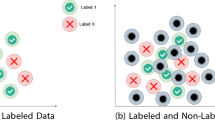Abstract
Two probabilistic model induction techniques, cart and constructor, are compared, via a series of experiments, in terms of their ability to induce models that are both interpretable and predictive. The experiments show that, although both algorithms are able to deliver classifiers with predictive performance close to that of the optimal Bayes rule,constructor is able to generate a probabilistic model that is more easily interpretable than the cart model. On the other hand, cart is a more mature algorithm and is capable of handling many more situations (e.g., real-valued training sets) thanconstructor. A variety of characteristics of both algorithms are compared, and suggestions for future research are made.
Similar content being viewed by others
References
Blau, P. M. and Duncan, O. D. (1967)The American Occupational Structure, John Wiley, New York.
Breiman, L., Friedman, J. H., Olshen, R. A. and Stone, C. J. (1984)Classification and Regression Trees, Wadsworth, Belmont.
Chang, K. C. and Fung, R. M. (1989) Node aggregation for distributed inference in Bayesian networks, inProceedings of the 11th International Joint Conference on Artificial Intelligence, Detroit.
Crawford, S. L. (1989) Extensions to the cart algorithm.International Journal of Man-Machine Studies,31, 197–217.
Freedman, D. A. (1987) As others see us: a case study in path analysis.Journal of Educational Statistics,12(2), 101–128.
Fung, R. M. and Crawford, S. L. (1990)constructor: a system for the induction of probabilistic models, inProceedings of the Eighth National Conference on Artificial Intelligence, Boston, pp. 762–769.
Fung, R. M., Crawford, S. L., Appelbaum, L. A. and Tong, R. M. (1990) An architecture for probabilistic concept-based information retrieval, inProceedings of the 13th International Conference on Research and Development in Information Retrieval, Brussels.
Gennari, J., Langley, P. and Fisher, D. (1990) Models of incremental concept formation.Artificial Intelligence,40(1–3), 11–61.
Lauritzen, S. L. (1982)Lectures on Contingency Tables. University of Aalborg Press, Aalborg, Denmark.
Lauritzen, S. L. and Spiegelhalter, D. J. (1988) Local computations with probabilities on graphical structures and their application in expert systems.Journal of the Royal Statistical Society B 50, 157–224.
Pearl, J. (1988)Probabilistic Reasoning in Intelligent Systems: Networks of Plausible Inference. Morgan Kaufmann, San Mateo, CA.
Pearl, J. and Verma, T. S. (1990) A formal theory of inductive causation. Technical report, Cognitive Systems Laboratory, UCLA.
Rebane, G. and Pearl, J. (1987) The recovery of causal poly-trees from statistical data, inProceedings of the 3rd Conference on Uncertainty in Artificial Intelligence.
Verma, T. S. and Pearl, J. (1990) Equivalence and synthesis of causal models, inProceedings of the 6th Conference on Uncertainty in Artificial Intelligence, Cambridge, MA, pp. 220–227.
Author information
Authors and Affiliations
Rights and permissions
About this article
Cite this article
Crawford, S.L., Fung, R.M. An analysis of two probabilistic model induction techniques. Stat Comput 2, 83–90 (1992). https://doi.org/10.1007/BF01889586
Received:
Accepted:
Issue Date:
DOI: https://doi.org/10.1007/BF01889586




